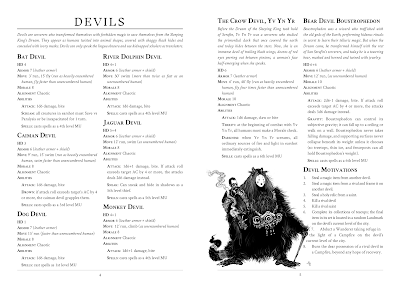san serafin is not really a dungeon, though it looks like one sometimes, but it is really more of a dangerous overworld in which other dungeons can be inserted. an important part of the feel of San Serafin are its most common residents, serafinos, who form a constant, low-grade puzzle that players have to deal with. I have not wanted to blog about it and ruin things, but players usually figure it out within a session anyway, and the fun of it is dealing with the problem, not figuring it out.
there is a Sleeping King, deep beneath the ground, so hateful he was buried alive by his own people, so virtuous he he did not die.
he dreams of a black city, unfolding from the earth like an evil flower, filled with remembrances of his lost kingdom. he dreams the dead to life and dreams the sun out of the sky.
he has dreamed his people into monsters. the Dream is in them and they are of the Dream, it is propagated by their acts and they are sustained by its existence.
serafinos are the people who used to live in San Serafín. now they are the impossible residents of an impossible city, with no mind or power but to endlessly act out the unlogic of their home.
all serafinos obey the following rules strictly:
behave well
Serafinos always act in the way most appropriate for their surroundings. On the street, they walk aimlessly; in a bar, they drink ancient liquor and pay with corroded coins
punish transgression
Serafinos react with hostility to any breach in ettiquette or order. Stealing, cutting in line, heckling, touching another Serafino, shouting, running, and fighting all upset them, at first attracting their attention and then compelling them to attack. Serafinos can freely breach etiquette to punish a transgressor, without reprisal from their fellows.
never rest
Serafinos continue a course of action until etiquette forces them to stop. They will dance forever unless a clock strikes twelve, or eat dust in a restaurant until they come to believe it has closed.
obey authority
Serafinos tend to obey orders spoken with conviction and believe claims of high office, but their reprisal for impersonation when they discover it is extraordinarily vicious.
reactions
Serafinos use a modified reaction table. They only make reactions when players have called attention to themselves in some way.
in the city
in San Serafin, there are always 3d6 lesser serafinos wandering the streets or stumbling through buildings nearby.
Lesser Serafino
it is shadowy and indistinct, like a distant figure in a dream or a person you see out of the corner of your eye. if you look closer, you can see the details resolve themselves just a moment after you should have noticed them: it has no face until you wonder why not, its eyes have no color until you notice they’re an indescribable non-shade, stitches force themselves out of the serafino’s clothes once you realize it’s just wearing a smoky black smear.
HD 1
Armor 10 (unarmored)
Speed ¾ human (spiderclimb, swim)
Morale 12
Alignment Chaotic
Abilities
- Maul: +1 to hit, 1d6 damage
- Climb: serafinos do not climb like a human. they just step up onto the wall like it’s another part of the floor and walk straight up it.
- Swim: in water, serafinos unravel into something filamentous and black, a bit like a cloud of smoke and a bit like a jellyfish.
Grand Serafino
its looks human, but its shadow roils like smoke behind it and the pavement flexes like a beaten drum beneath its feet. When angered or when fighting, it flickers between shapes: a child, a tiger, a screaming statue, a cloud of butterflies, a column of fire, anything ever dreamed of.
Stats and abilities as djinn, except that it cannot use whirlwind. Grand Serafinos can use Shapechange at will, except that anyone can Save vs Magic to disbelieve it back to its original humanoid form. this is subjective, and the serafino can use Shapechange again to fool a person who has already disbelieved, so it might appear as a medusa to one person and an ancient red dragon to another.
any serafino that dies leaves behind its possessions, but its body is always small and shriveled, like something that only might have been human, and even then very long ago.

















